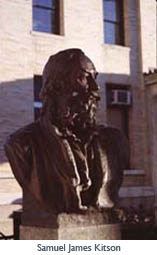Fordham University
441 East Fordham Road
Maurice J. Power
Archbishop John Hughes
installed 1891 bronze sculpture Private funding Samuel James Kitson
Orestes Augustus Brownson
Memorial, 1910 granite and bronze, 9' x 8' x 6' Bronx City of New York Parks and Recreation |
 |
Fordham University was founded in 1841 as St. John's College by the Right Reverend John Hughes, later to become the city's first Roman Catholic archbishop. Its first president, Right Reverend John McClosky, became the nation's first cardinal. The Jesuits bought the college in 1846. St. John's College was reestablished as a university in 1907, and became Fordham University.
Most of its greystone collegiate gothic buildings were designed by architect Emile G. Perrot between 1911 and 1930. Of particular interest is the early Rose Hill Manor House of rough-stone in the country Greek Revival style built in 1838.
Two literary tales relate to the campus. It is said that the university's 98 acres were the setting for James Fenimore Cooper's novel The Spy and that the bell,"Old Edgar," in University Church was the inspiration for Poe's poem The Bells.
The year 1891 marked the university's 50th anniversary and its first commissioned sculpture. On the campus of Fordham University at Fordham Road and Third Avenue stands the bronze figure of the university's founder, John Hughes designed by Irish born sculptor and foundry owner, Maurice J. Power (1838-1902).
On the Fordham University campus where commencement exercises were first held, is a colossal bronze bust atop a high granite pedestal of Orestes A. Brownson (1803-1876). The bust was completed in 1899 by Samuel J. Kitson.Brownson is best known today as a New England transcendentalist and friend of Ralph Waldo Emerson and Henry David Thoreau.
Brownson was a Presbyterian preacher and subsequently became a Universalist Minister, a Unitarian Minister, the pastor of his own religious organization, the Society for Christian Union and Progress, and in 1844 he converted to Catholicism. He was an active writer on society, politics, science and philosophy and a Democratic party leader. In recognition of his outspoken defense of American Catholicism, he was awarded Fordham's first honorary degree. In 1856 he was rebuked by Reverend Hughes for his socialist views expressed in a commencement address.
The bust was commissioned by the Catholic Club of New York in the late 1890s for its building on Central Park South. When the building was demolished 10 years later it was moved to Riverside Drive and 104th Street. In the 1930s it was overturned by vandals and put into storage. In 1941 Father Gannon, the president of Fordham who had been present at the 2nd unveiling of the bust and whose father had been president of the Catholic Club, petitioned the Parks Department for its placement on the campus. Today, the bust portrait is still safely installed at Fordham University atop a high granite pedestal.
Most of its greystone collegiate gothic buildings were designed by architect Emile G. Perrot between 1911 and 1930. Of particular interest is the early Rose Hill Manor House of rough-stone in the country Greek Revival style built in 1838.
Two literary tales relate to the campus. It is said that the university's 98 acres were the setting for James Fenimore Cooper's novel The Spy and that the bell,"Old Edgar," in University Church was the inspiration for Poe's poem The Bells.
The year 1891 marked the university's 50th anniversary and its first commissioned sculpture. On the campus of Fordham University at Fordham Road and Third Avenue stands the bronze figure of the university's founder, John Hughes designed by Irish born sculptor and foundry owner, Maurice J. Power (1838-1902).
On the Fordham University campus where commencement exercises were first held, is a colossal bronze bust atop a high granite pedestal of Orestes A. Brownson (1803-1876). The bust was completed in 1899 by Samuel J. Kitson.Brownson is best known today as a New England transcendentalist and friend of Ralph Waldo Emerson and Henry David Thoreau.
Brownson was a Presbyterian preacher and subsequently became a Universalist Minister, a Unitarian Minister, the pastor of his own religious organization, the Society for Christian Union and Progress, and in 1844 he converted to Catholicism. He was an active writer on society, politics, science and philosophy and a Democratic party leader. In recognition of his outspoken defense of American Catholicism, he was awarded Fordham's first honorary degree. In 1856 he was rebuked by Reverend Hughes for his socialist views expressed in a commencement address.
The bust was commissioned by the Catholic Club of New York in the late 1890s for its building on Central Park South. When the building was demolished 10 years later it was moved to Riverside Drive and 104th Street. In the 1930s it was overturned by vandals and put into storage. In 1941 Father Gannon, the president of Fordham who had been present at the 2nd unveiling of the bust and whose father had been president of the Catholic Club, petitioned the Parks Department for its placement on the campus. Today, the bust portrait is still safely installed at Fordham University atop a high granite pedestal.
[More about the artists]
[More about the Fordham neighborhood]
[Visit the Fordham University website]